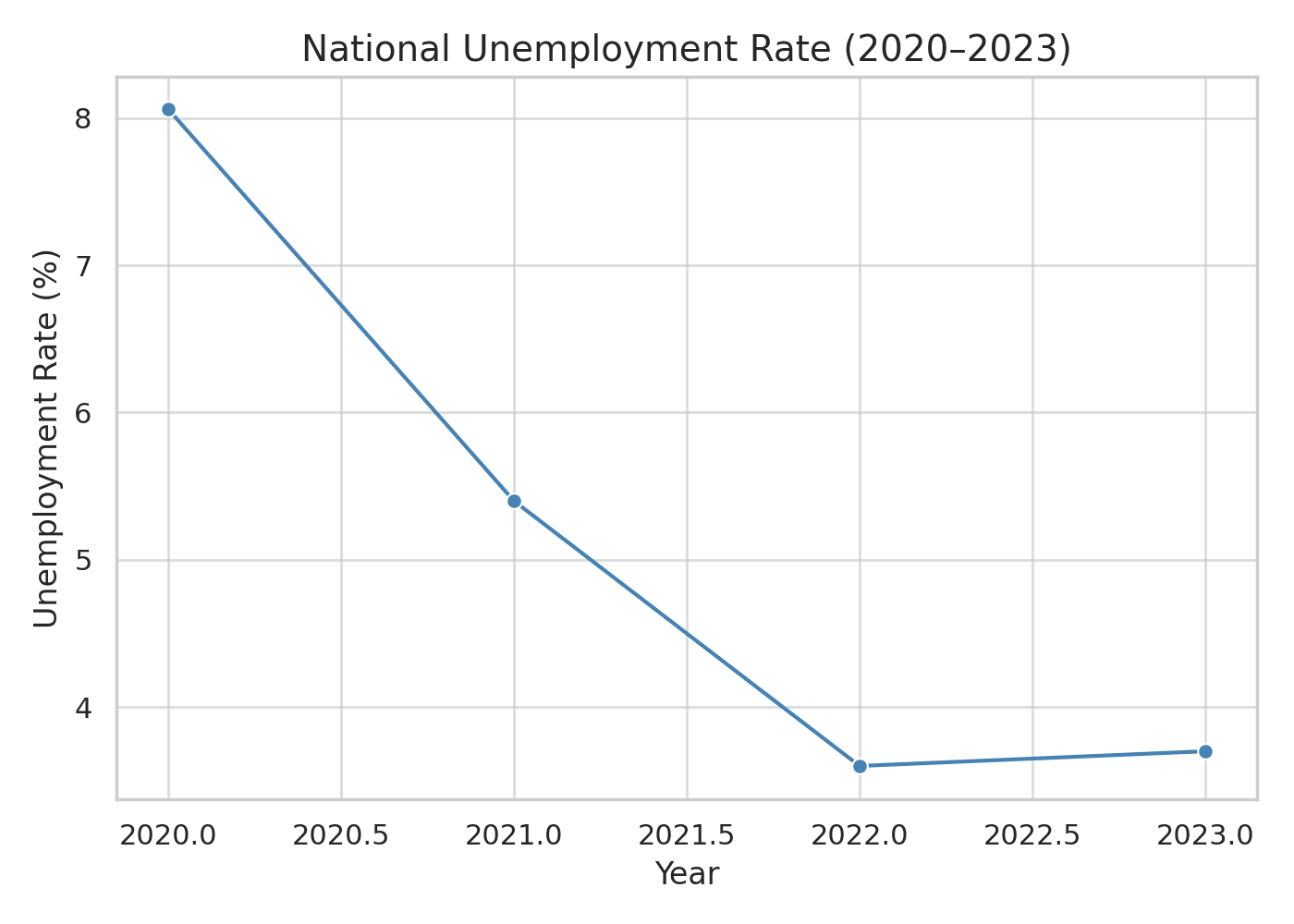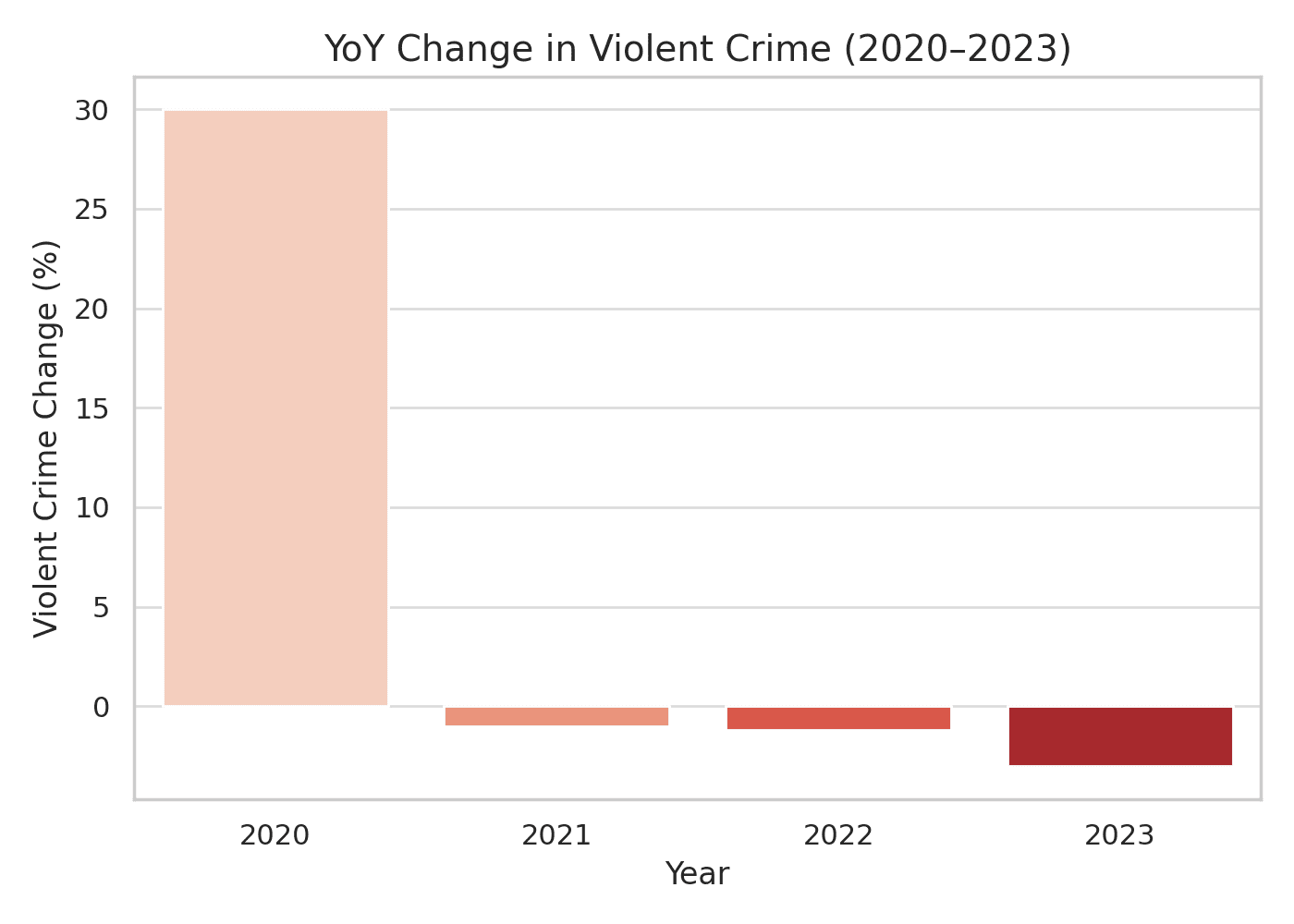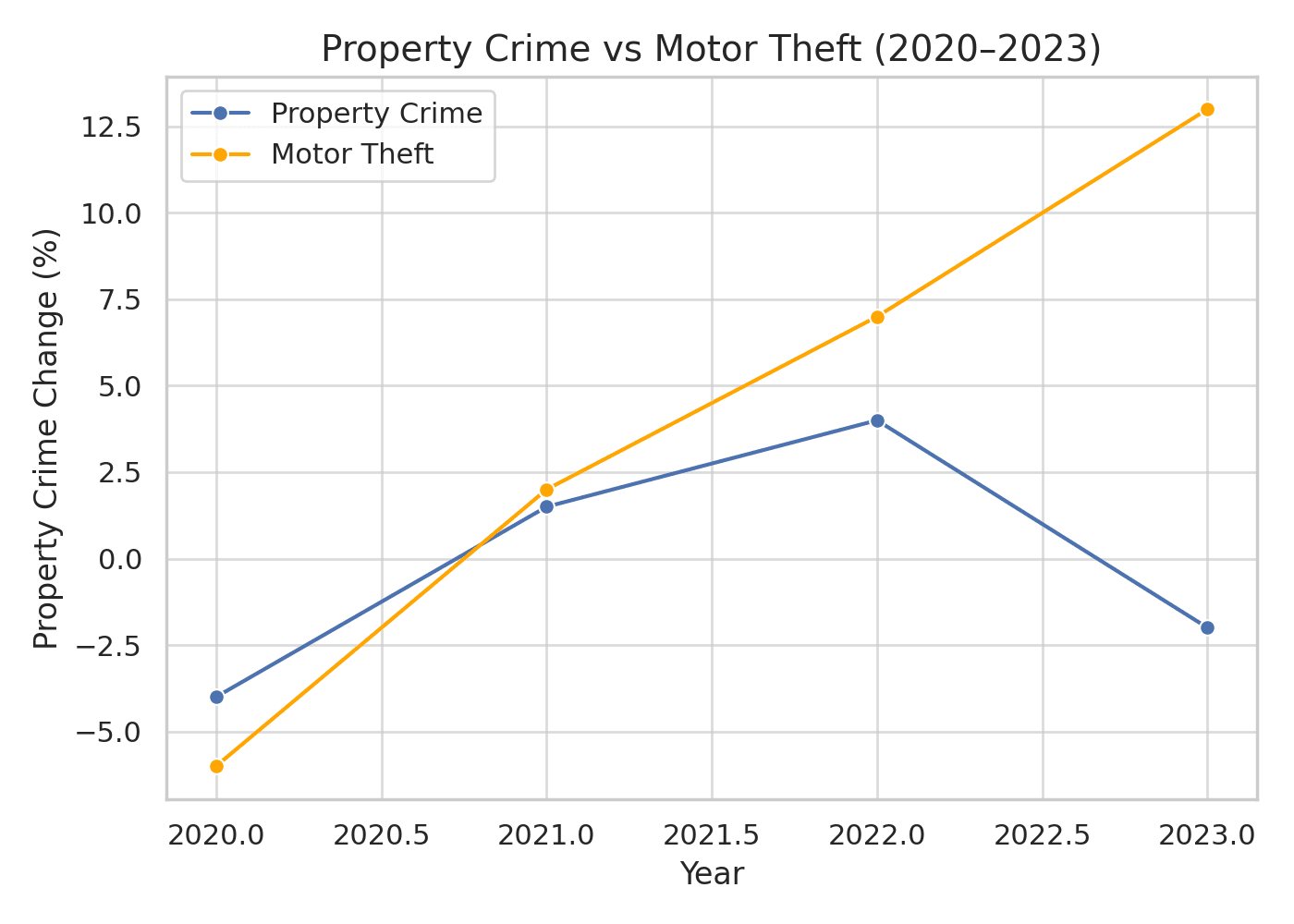Is Crime Linked to Unemployment?
An old stereotype prevails – that unemployment and crime are inextricably linked. Yet establishing such a link is not so easy.
Our analysis considers the data around the issue over the last few years, with Covid being a pivotal factor. We also look at where crime figures are worst, where they’ve seen the biggest up- and downturns, and whether or not we can, after all, establish definitive links between crime and unemployment.
Recent Unemployment and Crime Trends in the U.S.
In 2019, unemployment in the U.S. was at 3.67%. Then Covid-19 and mass national lockdowns struck, pushing the unemployment rate to its April 2020 peak of 14.8%.
The final 2020 unemployment rate dropped over 6.5%, landing at 8.06% – still 4.39% higher than 2019 figures, with Nevada ending the year with the highest unemployment rate (13.5%).
Between 2021 and 2023, as the country recalibrated and steadied against the effects and after-effects of Covid-19, unemployment continued to fall, stabilizing at 3.7% – almost exactly the pre-Covid 2019 rate, with Nevada again having the highest unemployment rate at 5.2%.

Nevada is an interesting initial test case regarding the establishment of potential links between crime and unemployment. In 2020, during the Covid-19 outbreak, Nevada’s violent and property crime rates significantly fell compared to the previous year – despite having the highest unemployment rate in the country. Yet, homicide rates soared – as they did across the U.S.
As Nevada’s post-Covid unemployment rate began to fall, general crime rates failed to mirror this downward trend. In fact, analysis of Pew Research Center data tells us that 2022 marked the first year-over-year increase in Nevada’s violent crime rate since 2015.
So, if a link exists between unemployment and crime, in Nevada’s case, figures make the link difficult to establish – beyond a tenuous suggestion that Covid-19, or Covid-19-linked job losses, possibly influenced the homicide rate in the state.
After leading Nevada, here are the other top-ranking states for employment in the U.S. in 2020 and 2023.
Unemployment Rate – Top Ten States
2020 – 2023
- Nevada – 13.5% / Nevada – 5.2%
- Hawaii – 11.6% / California – 4.7%
- California – 10.1% / Illinois – 4.5%
- Michigan – 10.0% / New Jersey – 4.3%
- New York – 9.8% / Kentucky – 4.3%
- New Jersey – 9.5% / Washington – 4.2%
- Massachusetts – 9.3% / Alaska – 4.2%
- Rhode Island – 9.2% / New York – 4.1%
- Pennsylvania – 8.8% / Texas – 4.0%
- Washington – 8.7% / West Virginia – 3.9%
Across the country, violent crime figures underwent initial seismic changes during the same period. In 2020, nationwide homicide rates increased nearly 30% compared to 2019 figures—the largest one-year spike in FBI records.
Yet by 2022, analysis of study data confirmed that violent crime rates were down to almost pre-pandemic levels, and by the end of 2023, violent crime further decreased by 3%, with homicide rates plummeting 12% – broadly mirroring unemployment trends, and suggesting a potential link between the two.

(Though the District of Columbia ranks top of the 2023 crime rate list, it’s a federal district subject to a complex interplay of local, federal, and state agencies involved in law enforcement and prosecution.
As such, we consider it a special case, and for ranking purposes have provided a list solely featuring U.S. states.) Here are the ten states with the highest crime rates in 2020 and 2023.
Violent Crime Rate – Top Ten States (Incidents Per 100,000 Residents)
2020 – 2023
- Alaska – 837.8 / New Mexico – 749.3
- New Mexico – 778.2 / Alaska – 726.3
- Tennessee – 672.7 / Tennessee – 628.2
- Arkansas – 671.9 / Arkansas – 619.9
- Louisiana – 639.4 / Louisiana – 548.0
- Missouri – 543.6 / California – 508.2
- South Carolina – 530.7 / Colorado – 474.0
- Alabama – 511.8 / South Carolina – 471.0
- Arizona – 484.8 / Missouri – 458.7
- Michigan – 478.0 / Michigan – 457.2
Regarding property crime, the figures follow a different pattern. 2020 Covid-19 closures and curfews limited the opportunity for crimes like theft, property damage, burglary, vandalism, and shoplifting.
Our analysis of FBI data reveals that, during 2020, property crimes hit their lowest level since 1990. As the country returned to something like normal service, property crime rates rose – with car thefts in particular showing a sharp increase (13%) by 2023 – a figure that contradicts the suggestion that unemployment and crime are linked.

So, regarding property crime, as unemployment levels fell, incidents in some states increased. Here’s a closer look at the most significant property crime rates in 2020 and 2023.
Property Crime Rate – Top Ten States (Incidents Per 100,000 Residents, Statista/BeautyfyData Stats)
2020 2023
- Louisiana – 2,884.40 New Mexico – 2,887.5
- New Mexico – 2,841.90 Washington – 2,886.7
- Colorado – 2,833.80 Colorado – 2,878.9
- Washington – 2,732.40 Louisiana – 2,630.2
- South Carolina – 2,721.40 Oregon – 2,590.7
- Oklahoma – 2,705.60 Nevada – 2,517.0
- Oregon – 2,659 Tennessee – 2,361.8
- Arkansas – 2,613.40 California – 2,325.6
- Missouri – 2,531 Texas – 2,238.3
- Alaska – 1,852 Alaska – 1,789
California – not even amongst the top ten property crime states in 2020 – takes eighth spot by 2023. (Add to this its sixth spot on the 2023 violent crime list – from nowhere near the top ten in 2020.)
This is despite its unemployment rate falling from 10.1% to 4.7% over the same period – and a gain of over three million jobs. Such figures fail to confirm any direct link between those types of crime and unemployment.
In Washington State, unemployment rose significantly in 2020, peaking at 8.5%. Since then, unemployment has dropped: by 2023 it had stabilized at 4.2%. Yet, Washington State has seen its crime rates rise since 2020. Violent crime in the state rose 20% between 2020 and 2023, with property crime also up on 2020 levels, at a much higher rate than the national average.
Clearly, some states represent exceptions to any national trends – diminishing the possibility of attributing broad nationwide claims regarding links between unemployment and crime.
Biggest Rise/Fall in Area Crime Rates
Some states have seen a sharp rise in crime over the past decade. Here are the top ten states subject to the biggest violent crime rate increases.
- South Dakota 188% percentage rise (2012-2022, USAFacts data)
- Montana 125%
- New Mexico 120%
- Alaska 104%
- Mississippi 103%
- Hawaii 100%
- Minnesota 90%
- Virginia 90%
- Colorado 85%
- Oregon 82%
Whereas, these states have seen the biggest drop in violent crime (1991-2022, USAFacts data)
- Florida -78.1%
- Illinois -72.4%
- Connecticut -72.2%
- New Jersey -68.0%
- New York -63.1%
- Rhode Island -62.7%
- Maryland -58.3%
- Massachusetts -56.3%
- California -54.2%
- Alabama -51.5%
Car Theft Hot Spots
Apart from violent crime and property damage, stolen cars are a key crime statistic, with car theft increasing considerably since 2020. Here are the states in the U.S. where car theft is a big problem.
- California 208,668 (cars stolen in 2023, Insurance Business stats)
- Texas 115,013
- Florida 46,213
- Washington 43,160
- Illinois 41,528
- Colorado 34,068
- New York 32,715
- Ohio 31,647
- Georgia 28,171
- Missouri 27,279
House Burglary Hot Spots
Another key crime metric is burglaries. Here are the ten states in which your house is most likely to be broken into.
- New Mexico 604 (burglaries per 100k people, FBI 2024 data)
- Washington 563
- Louisiana 497.8
- Oklahoma 482.6
- Arkansas 466.4
- Nevada 436.1
- Colorado 395.2
- California 371.9
- North Carolina 370.8
- Oregon 360.7
Drawing the Data Together
Unemployment levels soared during 2020. And it is possible to draw some potential links between crime and unemployment. As study data has shown, the Covid-19 pandemic meant that property crime fell; at the same time, homicide levels surged.

Ultimately, though, while there are some parallels between employment trends and some types of crime, there isn’t enough compelling overarching data to suggest that there is an absolute link between unemployment and crime in the U.S.
And at times, the data – the rise in property and car crime as unemployment fell – often suggests otherwise. Economic improvement doesn’t necessarily translate to less crime – just as unemployment fluctuations certainly do not precisely mirror crime statistical variations.
Our analysis of some of the granular differences at state level confirms that the causes of crime, and the unearthing of any potential links between crime and unemployment, are perhaps best understood on a state-by-state basis.
At Suzuki Law Criminal Defense and Injury Lawyers, we’re former prosecutors fighting for you, and we defend you if you’re charged with a crime, and aggressively litigate on your behalf if you’ve been injured. Get in touch today if you need any help or further information.

